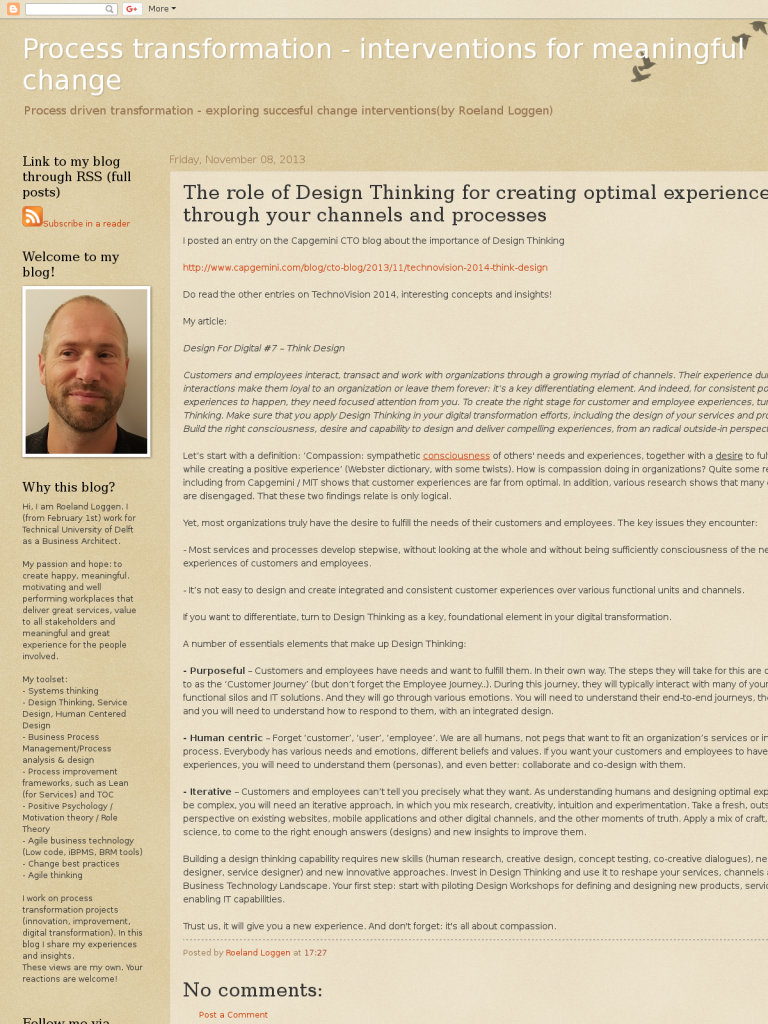The role of Design Thinking for creating optimal experiences through your channels and processes
Blog: Process transformation - interventions for meaningful change
I posted an entry on the Capgemini CTO blog about the importance of Design Thinking
http://www.capgemini.com/blog/cto-blog/2013/11/technovision-2014-think-design
Do read the other entries on TechnoVision 2014, interesting concepts and insights!
My article:
Design For Digital #7 – Think Design
Customers and employees interact, transact and work with organizations through a growing myriad of channels. Their experience during these interactions make them loyal to an organization or leave them forever: it’s a key differentiating element. And indeed, for consistent positive experiences to happen, they need focused attention from you. To create the right stage for customer and employee experiences, turn to Design Thinking. Make sure that you apply Design Thinking in your digital transformation efforts, including the design of your services and processes. Build the right consciousness, desire and capability to design and deliver compelling experiences, from an radical outside-in perspective. Delight!
Let’s start with a definition: ‘Compassion: sympathetic consciousness of others’ needs and experiences, together with a desire to fulfill the needs while creating a positive experience’ (Webster dictionary, with some twists). How is compassion doing in organizations? Quite some research, including from Capgemini / MIT shows that customer experiences are far from optimal. In addition, various research shows that many employees are disengaged. That these two findings relate is only logical.
Yet, most organizations truly have the desire to fulfill the needs of their customers and employees. The key issues they encounter:
– Most services and processes develop stepwise, without looking at the whole and without being sufficiently consciousness of the needs and experiences of customers and employees.
– It’s not easy to design and create integrated and consistent customer experiences over various functional units and channels.
If you want to differentiate, turn to Design Thinking as a key, foundational element in your digital transformation.
A number of essentials elements that make up Design Thinking:
– Purposeful – Customers and employees have needs and want to fulfill them. In their own way. The steps they will take for this are often referred to as the ‘Customer Journey’ (but don’t forget the Employee Journey..). During this journey, they will typically interact with many of your channels, functional silos and IT solutions. And they will go through various emotions. You will need to understand their end-to-end journeys, their emotions and you will need to understand how to respond to them, with an integrated design.
– Human centric – Forget ‘customer’, ‘user’, ‘employee’. We are all humans, not pegs that want to fit an organization’s services or internal process. Everybody has various needs and emotions, different beliefs and values. If you want your customers and employees to have great experiences, you will need to understand them (personas), and even better: collaborate and co-design with them.
– Iterative – Customers and employees can’t tell you precisely what they want. As understanding humans and designing optimal experiences can be complex, you will need an iterative approach, in which you mix research, creativity, intuition and experimentation. Take a fresh, outside-in perspective on existing websites, mobile applications and other digital channels, and the other moments of truth. Apply a mix of craft, art and science, to come to the right enough answers (designs) and new insights to improve them.
Building a design thinking capability requires new skills (human research, creative design, concept testing, co-creative dialogues), new roles (UX designer, service designer) and new innovative approaches. Invest in Design Thinking and use it to reshape your services, channels and your Business Technology Landscape. Your first step: start with piloting Design Workshops for defining and designing new products, services and enabling IT capabilities.
Trust us, it will give you a new experience. And don’t forget: it’s all about compassion.
Leave a Comment
You must be logged in to post a comment.








